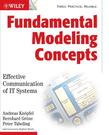基础建模理念
出版时间:2006-5 出版社:John Wiley & Sons Inc 作者:Knopfel, Andreas/ Grone, Bernhard/ Tabeling, Peter 页数:334
内容概要
To develop information processing systems requires effective and efficient communication between many people. In order to understand requirements and design decisions, there is a need for a common conceptual model of the system: one that represents the architecture of the system. Communication between experts from different domains requires a common terminology and notation that is easy to apply. This is where Fundamental Modeling Concepts (FMC) steps in. Primarily FMC is a consistent and coherent way to think and talk about information processing systems. It enables people to communicate the concepts and structures of complex information systems in an efficient way. FMC provides you with a powerful tool for the early stages of system analysis and design. It is independent of any application domain or platform technology. It can be applied to business systems, to embedded systems or interactive systems, to systems which are implemented by programming computer systems, to wiring hardware components, to organizing the workflow between humans or to combined solutions. Starting from a simple example, you will become familiar with the different types of system structures and their graphical representation. The authors’ unique approach presents mappings between conceptual and implementation models and provides you with guidelines for the identification of system structures. 作者简介: Dr. Andreas Knöpfel is an FMC expert and learnt much about its practical value during his four years at SAP. He now works as a system analyst and requirements engineer.
书籍目录
Foreword. Preface. 1 Introduction. 1.1 The need for communication. 1.2 The FMC Idea. 1.3 Outline of this book. 2 Compositional Structures. 2.1 An example: The travel agency. 2.2 Modeling the structure of a system. 2.3 Agents accessing storages. 2.4 Agents communicate via channels. 2.5 Summary. 2.6 Exercises. 3 Dynamic Structures. 3.1 Petrinets: Basic principles. 3.2 Conflicts and conditions. 3.3 Basic patterns. 3.4 Responsibilities and scope boundaries. 3.5 Summary. 3.6 Exercises. 4 Value Structures and Mind Maps. 4.1 Entity sets and relationships. 4.2 Cardinalities. 4.3 Predicates and roles. 4.4 Partitions. 4.5 Reification. 4.6 Summary. 4.7 Exercises. 5 FMC Basics: Summary. 6 Reinforcing the Concepts. 6.1 The meta model: A mind map to FMC. 6.2 Operational versus control state. 6.3 Block diagrams: Advanced concepts. 6.4 Petrinets: Advanced concepts. 6.5 Non-hierarchical transformations and semantic layers. 6.6 Exercises. 7 Towards Implementation Structures. 7.1 System structure versus software structure. 7.2 From Processor to processes. 7.3 Distribution, concurrency and synchronization. 7.4 From FMC to objects and classes. 7.5 Conceptual patterns versus software patterns. 8 Applying FMC in Your Daily Work. 8.1 Becoming comfortable with FMC. 8.2 Describing existing systems with FMC. 8.3 Using FMC in construction. 8.4 Using FMCdiagrams to support communication. 8.5 Guidelines for didactical modeling. 8.6 Cost and benefit of modeling. 9 Modeling and Visualization Guidelines. 9.1 Introduction. 9.2 Increasingt he reader’s perception. 9.3 Increasing comprehension. 9.4 Secondary notation, patterns and pitfalls. 10 Relationship with Other Modeling Approaches. 10.1 Comparing FMC with Structured Analysis. 10.2 FMC and the Unified Modeling Language. 11 A System of Server Patterns 247 11.1 Applicationdomain. 11.2 A pattern language for request processing servers. 11.3 Example applications. 11.4 Conclusion and further research. Epilogue. A Solutions. B Reference Sheets. C Glossary. References. Index.
图书封面
评论、评分、阅读与下载
用户评论 (总计0条)
推荐图书
- 数字权利管理
- 中国风水全书
- 城市公共交通行车安全管理
- 北京至上海高速公路 2003年旅游版
- 客户回报率
- 效应力
- 现代企业管理
- 与公司共命运2
- 网络设备基础教程与实验指导
- 西门子自动化系统实战S7和PCS7应用实例
- 憨山大师佛学思想研究
- 助天生物-道教生态观与现代文明
- 常见疾病饮食宜忌
- 性能评价用形式方法与随机模型
- 应用可靠构件的基础结构系统/会议论文集Architecting systems with
- 慢性低血压病的中医治疗
- 常见内科病中医外治法
- 周杰伦陶喆吉他音乐精选
- 最能赚钱的九个人
- 企业家成长环境和培育机制研究
- 零起点创业投资
- 四季饮食宜忌
- 吃对水果保健康
- 临床医嘱手册
- 好身体是吃出来的
相关图书
- TiVo 程序设计初阶 Beginning TiVo Programming
- Excel 2007 VBA 程序师参考手册 Excel 2007 VBA Programmer's Reference
- Access 2007 VBA 宝典
- 数字国土
- PC All-in-One桌面参考傻瓜书 PCs All-in-One Desk Reference For Dummies
- 思想工厂
- 粗糙集与知识技术Rough sets and knowledge technology
- 网络百科The Internet Encyclopedia
- 专业 SQL Server 2005 Administration盘 Professional SQL Server 2005 Administration
- 图解表示与推理
- 推理Web服务
- 东方语言计算机处理,东方以远
- Blackwell管理百科全书
- Blackwell管理百科全书
- Blackwell管理百科全书
- Blackwell管理百科全书
- (学长告诉你
- MacBookTM 傻瓜书 MacBook For Dummies
- 专业Visual Studio 2005团队系统 Professional Visual Studio 2005 Team System
- 掌握微软SQL服务器2005 Mastering Microsoft SQL Server 2005
- MySpaceTM Visual QuickTM 诀窍 MySpace Visual Quick Tips
- 道义逻辑与人工规范系统
- 有限状态方法与自然语言处理
- 协调模型与语言
- 轻松学画画
